CASE STUDY:
LARGE MOVING WALL FOR POST PRODUCTION DOLBY STUDIO
Customer’s needs
The client company runs one of the most successful post production studio facilities in the UK. They are responsible for editing the sound, adding voiceovers and special effects to videos, TV adverts and films. Their clients range from the top broadcasting and film companies to most of the large advertising agencies.
As part of an expansion programme a new studio complex was commissioned in central London. This included one of the first Dolby 5.1 surround sound studio facilities. One condition of the Dolby License requires that the room volume to be a certain size in order to mix the audio.
In most post production studios the voice over section is only used for a small part of the recording process. Therefore during the mixing stage of most projects the voice over booth is effectively wasted space. As space in London is expensive the client wanted to make better use of the space in the facility.
what is Marine Applications click here
Ideas2Reality was approached to suggest and evaluate possible solutions for the client. Of the solutions proposed the one chosen was to design and install a very large glass wall that divided the room to provide the sound proof voice over booth when needed. This could be retracted into the ceiling during the mixing phase. Then when the engineer needed to mix the various audio tracks the wall could be retracted into the ceiling so that the space conforms to the Dolby sound standards.
Because of the size of the room and the performance requirements of the studio a number of challenges faced the designers. These included:
• Project management – the installation of the whole system was to take place during a major rebuilding of a number of the clients studios within a short period of time and without causing delays to the rest of the building works or the normal day to day running of the studio.
• The wall had to be double glazed with very thick glass (22 & 27mm glass) to prevent sound being transmitted through the glass.
• The movement of the wall had to be extremely quiet so that its operation did not affect other studios in the complex.
• When down the level of sound isolation between the two rooms had to be extremely high.
• The size of the unit meant that at the time the two panels would be the largest pieces of toughened glass made in Europe.
• The installation work would have to take place outside office hours so that the studios operated by other companies in the building were not disturbed during the day.
• The structure of the studio itself had to be fully isolated from the vibrations of the rest of the building.
• The loads caused by the movement of the wall were too high for standard methods used in studio construction. As a result the whole studio was designed and constructed as a steel framework.
• The size and power required to operate the wall meant that the control system had to incorporate all the necessary safety features and sensors to prevent injury to anybody using the studio.
• The operation of the wall had to be completely automatic so that any studio engineer could operate the system.
• The reliability of the system was most important. High studio costs mean that breakdowns would cause loss of profits.
How the customer’s needs were met
A detailed design project was undertaken covering all aspects of the project including interfacings with the various trades and other companies working on site. Timelines and CPA programmes were produced and updated weekly.
The studio shell and the wall components were designed to be manufactured offsite in a number of sections. These were sized to be able to be carried through the building to the studio site and then bolted together.
Transport was further complicated by the location of the studio which was on the second floor of a building in one of the busiest parts of London. For example this required the glass panels being craned over a building and in through the enlarged windows on the correct floor then manhandled through the complete complex prior to installation.
The final installation consists of a steel framed studio which was isolated from the building and lined with a wooden sub frame. To this was attached two linear tracks at each side on which the assembled door weighing in excess of 3 tons moved. The actuation was by means of four servo motors controlled by power amplifiers and a microprocessor motion control unit.
The main lift motion was via two large ball screws fitted with electronic brakes which locked in the event of a power failure or the emergency controls being activated. Infrared sensors were positioned either side of the unit to prevent operation if a person either approached the unit while it was operating or was in the way before operation started.
Find out more info.

